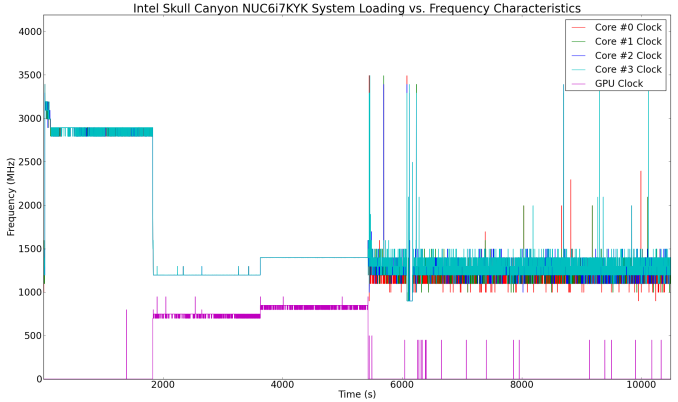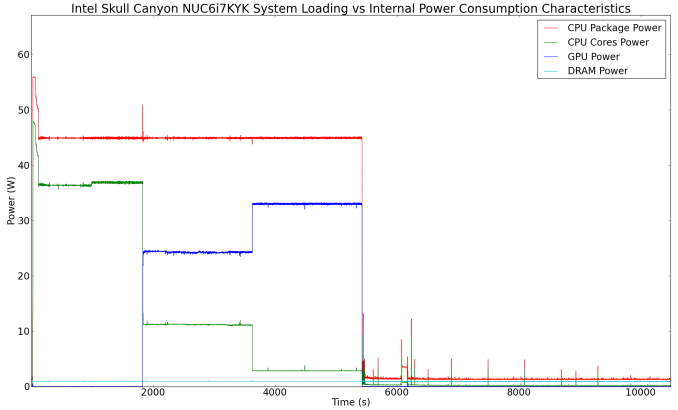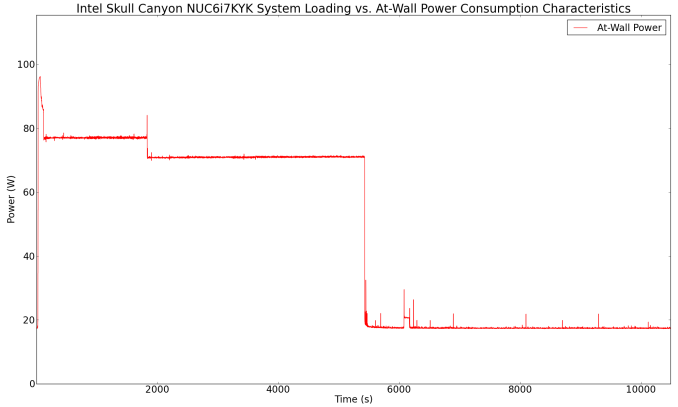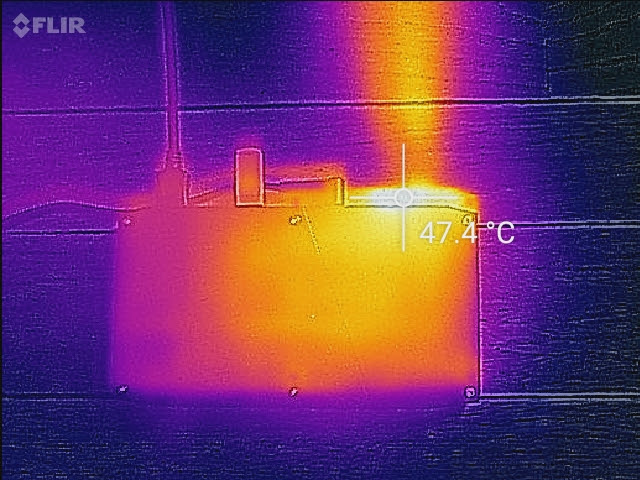The Intel Skull Canyon NUC6i7KYK mini-PC Review
by Ganesh T S on May 23, 2016 8:00 AM ESTPower Consumption and Thermal Performance
The power consumption at the wall was measured with a 1080p display being driven through the HDMI port. In the graphs below, we compare the idle and load power of the Intel NUC6i7KYK (Skull Canyon) with other low power PCs evaluated before. For load power consumption, we ran Furmark 1.12.0 and Prime95 v27.9 together. The idle number is a bit disappointing, though, I assume that a change in the BIOS to the low power profile could help improve things. Otherwise, the idle number is just slightly higher than what is typical for a system with a 45W TDP CPU and a PCIe M.2 SSD.


The load power number in the graph above is the maximum sustained value. As we can see from the graphs below, instantaneous peak numbers can go as high as 95W. Addition of bus-powered USB devices will also tend to drive up this number further.
Our thermal stress routine starts with the system at idle, followed by 30 minutes of pure CPU loading. This is followed by another 30 minutes of both CPU and GPU being loaded simultaneously. After this, the CPU load gets removed, allowing the GPU to be loaded alone for another 30 minutes. The various clocks in the system as well as the temperatures within the unit are presented below.
The graph below present the power consumption profile of various blocks in the CPU package during the course of our thermal stress. Following that, we have the power consumption at the wall for the system during the same period.
According to the official specifications, the junction temperature of the Core i7-6770HQ is 100 C. Unfortunately, the cooling solution is not able to prevent the CPU from hitting it with turbo speeds activated. However, the frequency does remain above the base 2.6 GHz throughout the pure CPU loading segment. The package power settles down to a steady 45W, and that continues throughout the duration of our test. Our only concern is that the cooling solution keeps the temperature of the cores too close to the junction temperature during periods of heavy CPU load. Once the load gets distributed across both the CPU and the GPU, we see the package come down to around 90C.
Another important aspect to keep note of while evaluating mini-PCs is the chassis temperature. Using the Android version of the FLIR One thermal imager, we observed the chassis temperature after the CPU package temperature reached the steady state value in the above graph.
We have additional thermal images in the gallery below.
The maximum chassis temperature observed by the thermal imager was slightly above 60 C near the fan's exhaust vent. At that point, a sound level Android app running on the HTC One M7 recorded 59 dB. For comparison purposes, the Zotac ZBOX MAGNUS EN970 recorded 50 dB in a similar scenario.







_thumb.jpg)

_thumb.jpg)

_thumb.jpg)









133 Comments
View All Comments
FlyingAarvark - Monday, May 23, 2016 - link
All of the Skull Canyon reviews so far online have been relative failures. I hate to bash this work but a few points that need to be said.To only test this with 2133Mhz is a shame. Intel stated that 2400Mhz works without a FSB OC and you can run up to 3000Mhz with one. That would change the gaming performance tremendously but not a single site has bothered testing this.
We just didn't learn anything that wasn't easily known from just looking at this on Newegg. We knew it would be really fast for the size/power requirements. We knew it would be fairly hot on-load due to past NUCs. But we didn't know how it would react with DDR4 2400/2800/3000+.
The other problem is that there's concern expressed in the review that bidirectional 4GB/sec bandwidth isn't enough. Its been proven and known if you look into it that PCIE 1.0 x16 (4GB/sec) does not bottleneck a GTX 980. Skull Canyon should be closer to 5GB/sec than 4GB as well. This wasn't tested with a Razer Core, but I think there's a really good change this is the fastest stock gaming CPU on the market today when paired with a discrete GPU due to the 128MB L4. It was shown that Broadwell 5775Cs were already holding that crown in the past.
Considering how incredibly impressive this NUC is already with its small size, low power draw, various Thunderbolt3 options (storage/GPU/docks): both of these points on faster DDR4 and 128MB L4 impact with a dGPU would make it even more impressive than it already is and probably result in slam dunk territory.
I think everyone in the tech community is massively missing the mark on this one! It just hasn't been properly tested. Intel absolutely nailed this product but is failing to properly instruct reviewers on what to test. Send me a sample, forumemail123 at g mail. I'll do it right.
jardows2 - Monday, May 23, 2016 - link
So, you want this product reviewed in tests that will show it in a better light, and ignore all the standard tests that give it an apples-to-apples comparison, showing that Intel has a long ways to go to provide good value to their customers in this market segment?FlyingAarvark - Monday, May 23, 2016 - link
Ah an AMD poverty gamer arrives. Apples to apples against what? Older NUCs? There is no other competition for this small of a form factor. Certainly not from AMDone.I'm asking that the things that all of us who have been so excited about this product have wanted to see. DDR4-3000 IGP gaming performance and Razer Core FuryX or 980Ti performance.
As I noted, this review told me absolutely nothing that wasn't already known just through common sense. No one will buy this thing for a ho-hum NUC, there's already plenty of those. We're buying them for the size/performance combo and going to run 3000Mhz DDR4 or Razer Core with it.
JoeyJoJo123 - Monday, May 23, 2016 - link
Nobody said anything about AMD, dude.jardows2 - Tuesday, May 24, 2016 - link
You just showed your true colors. I am anything but an "AMD poverty gamer." I need to know how this device compares to other computing devices, so I can determine if the small form factor benefit is worth the performance hit. Very few people are going to have a demand for a computer that fits a particular small form factor, and are willing to do anything to hit that size requirement. Most people just want the best value, and size is a component to that.If we are performing tests that show best case scenario for this unit, then we'd have to do the same for every other bare-bones unit. Then there would be no true comparison, and each piece would be no better than a cnet review bought and paid for by the manufacturer, and we would be no better informed.
FlyingAarvark - Tuesday, May 24, 2016 - link
Nice attempt at digging yourself out of that hole: you'd be pissed to see this thing shown in a positive light because as you said supposedly, "Intel has a long ways to go to provide good value". Shows how much you know, just taking the typical fanboy stance on this thing without knowing what you're even looking at- much like this review.The point remains: people want to see this used with varying RAM speeds. It affects the gaming performance greatly due to the IGP. Also people want to see it benched with a 980Ti / 1080 to compare to other high end gaming CPUs.
There's absolutely no reason that's "best case" at all. It's just asking for a full review.
stux - Monday, May 23, 2016 - link
I'm curious if the BIOS supports RAID0/1 and if so, what the performance from dual sm950s in RAID0 is.Sounds like that'd be bumping up against the DMI bottleneck.
revanchrist - Monday, May 23, 2016 - link
Very dissapointed TBH. i7 5775C performs on par with a GTX 750, so i thought this 6770HQ packed with a much stronger integrated graphics and double the eDRAM will be a monster but instead it performed much weaker, can't even matched a 5675C let alone a 5775C. I guess the power limit and TDP really limit the potential of the iGPU. Sigh. Probably need to wait until 7nm CPU to have a playable 1080p integrated graphics solution.spikebike - Tuesday, May 24, 2016 - link
Maybe the drivers haven't caught up. Or maybe it's heavily throttled because of heat. Seems very strange that it's not a substantial upgrade from the 5675c or 5775c. Hopefully, something else with a similar form factor will ship with the same CPU. Note the very wide difference between the two gtx 960 based units in this review.ganeshts - Tuesday, May 24, 2016 - link
This is a 45W TDP part, while the 5775C is a 65W TDP part. That is a substantial difference, as a larger TDP allows more leeway for the GPU than just the 20W difference would suggest.Also, not sure why multiple commentators are talking about two GTX 960 / same GPU when it comes to the GB-BXi5G-760 and the MAGNUS EN970. They are not the same GPU at all - the former uses the Kepler GK104-based 870M, while the latter uses the Maxwell GM104-based 970M.